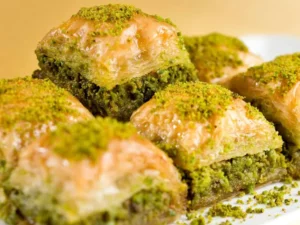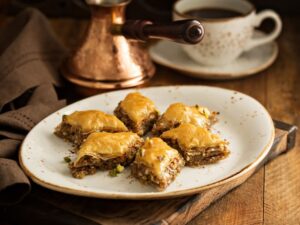Baklava: The Delicious Sweet

Baklava, this sweet, delicious, and mouthwatering dessert, has always been considered one of the tastiest foods in the world that many continuously enjoy. It has a long history and ancient origins that date back to ancient times and remains a beloved dessert in many cultures and countries. In this article, we will explore the delightful world of baklava, learn about its nature, origins, and preparation method, as well as the special occasions it is served. Get ready for a fun culinary adventure as we di…
What is Baklava?
Baklava is a type of dessert made from layers of phyllo dough, nuts, and sugary syrup. It is known for its crispy texture and rich flavors that make it a favorite sweet in many cultures, from Eastern Europe to the Middle East. The layers of dough are usually filled with finely chopped nuts, such as pistachios, walnuts, or almonds, adding a crunchy flavor and a touch of color to the baklava. After baking, the dessert is generously soaked in sugary syrup, giving it an irresistible sweetness and flavor.
What are the Origins of Baklava?

The true origins of baklava remain shrouded in mystery, dating back thousands of years. Some theories suggest that baklava may have originated in Mesopotamia, while others point to its emergence in the Ottoman Empire. Regardless of its exact origins, baklava traveled through history and spread to various regions worldwide, with each region adding its own special touch to the recipe.
The Story of Baklava
Over the centuries, baklava has been adopted and adapted by various cultures, contributing to its development. In ancient Mesopotamia, early versions of baklava likely resembled cakes made from fruit dough and honey. With the historical conquests and cultural exchanges, this delicious recipe traveled from culture to culture and from country to country. It was refined over the years and evolved into the baklava we know and serve today.
How is Baklava Served?

Baklava is usually served on its own, but it can also be accompanied by a variety of hot or cold drinks, depending on tastes and sometimes local customs. In some regions, it is served with Turkish coffee, which highlights its sweet flavors and crispy texture. Others prefer to enjoy baklava with mint tea, offering a refreshing mix and fragrant aroma.
How is Baklava Prepared?
Preparing baklava is a delicate art that requires patience and knowledge. First, the layers of phyllo dough are prepared by spreading them out thinly and stacking them. Then, generous layers of finely chopped nuts are added between the layers of dough, creating delectable layers. After baking, sugary syrup is poured over the hot baklava, allowing the dessert to absorb all the sweet flavors.
How is Baklava Eaten?
Baklava is often cut into small squares or triangles before serving. This shape makes it easy to eat without worrying about crumbs. Some people prefer to eat baklava with their hands, savoring each bite, while others prefer to use a fork for a more elegant experience and to avoid making a mess.
When is Baklava Prepared?
Baklava is especially popular during holidays and special occasions in many cultures. It is often prepared during religious celebrations, such as Eid al-Fitr in the Islamic world, where families share these sweets to celebrate the end of Ramadan. It is also present at weddings and family gatherings, adding a sweet touch to these joyful moments. It can also be enjoyed any day you crave it, as its delicious taste makes you want to enjoy it from time to time, at any time.
Baklava Recipe:
Ingredients:
400 grams of the phyllo dough
250 grams of nuts (almonds, walnuts, or pistachios), finely chopped
150 grams of melted butter
150 grams of sugar
1 teaspoon of ground cinnamon
1 tablespoon of orange blossom water (optional)
For the syrup:
200 ml of water
200 grams of sugar
1 cinnamon stick
1 tablespoon of some lemon juice
Method:
1-Preheat your oven to 180°C.
2- Combine the already chopped nuts, then sugar, and the cinnamon in a bowl, then set aside.
3-Grease a rectangular baking tray with melted butter.
4-Unroll the phyllo dough and cut it to the size of the tray.
5-Lay one sheet of the phyllo dough in the tray and brush the dough with the melted butter. Repeat this with 6-8 sheets.
6-Add a layer of the nut mixture over the dough.
8-Continue layering the sheets and nuts until the ingredients are used up. Finish with a layer of phyllo dough.
9-Use a knife that’s sharp, and cut this baklava into diamonds or squares.
10-Bake the baklava for 45 minutes to an hour, or until it appears golden and feels crispy.
While the baklava is baking, prepare the sugary syrup. To do this, boil the water, sugar, cinnamon stick, and the lemon juice. Then let it simmer for 10 minutes until the syrup thickens slightly.
11-After baking, pour the hot syrup over the hot baklava. Then let it rest for an hour to absorb the syrup and become tender.
12-For a finishing touch, you can sprinkle some chopped pistachios or almonds over the top of the baklava before serving. And it’s ready!
Baklava is best enjoyed on the same day it is made, but it can also be stored in an airtight container for several days. Enjoy this delicious sweet with a cup of coffee or mint tea for an unforgettable culinary experience! Bon appétit!
Baklava is more than just a dessert. Its rich history and subtle flavors reflect the many cultures that have contributed to its development. From its ancient origins to its presence on festive tables today, baklava continues to delight taste buds around the world. Whether to celebrate special occasions or simply to enjoy a sweet touch, this traditional dessert will not disappoint sweet lovers seeking luxurious flavors. So why not try tasting baklava on your next culinary adventure?
In addition, making baklava is a fun experience that brings the family together in the kitchen. Children can help adults arrange the layers of dough and place the nuts, creating an atmosphere of cooperation and fun. This type of family activity strengthens bonds and adds happy moments to shared memories.
Baklava is not just a dessert; it is a symbol of generosity and celebration in many cultures. During holidays and special occasions, serving baklava to guests is a sign of respect and appreciation. This delicious dessert goes beyond being just food, becoming part of the rich traditions and cultures that connect people across generations.
The journey of discovering baklava takes us into the depths of history and culture, where we learn about the story of this dessert and how it became an integral part of celebrations and happy occasions. So, the next time you enjoy a piece of baklava, remember that it carries tales and secrets from the past, reflecting people’s love for food and beautiful traditions.
In conclusion, baklava embodies the joy and great taste that connects us to the past and brings happiness to the present. Each piece of baklava carries a unique and special experience worth savoring. So, don’t hesitate to try making it yourself or tasting it at one of the upcoming occasions to participate in this rich and delicious heritage.
